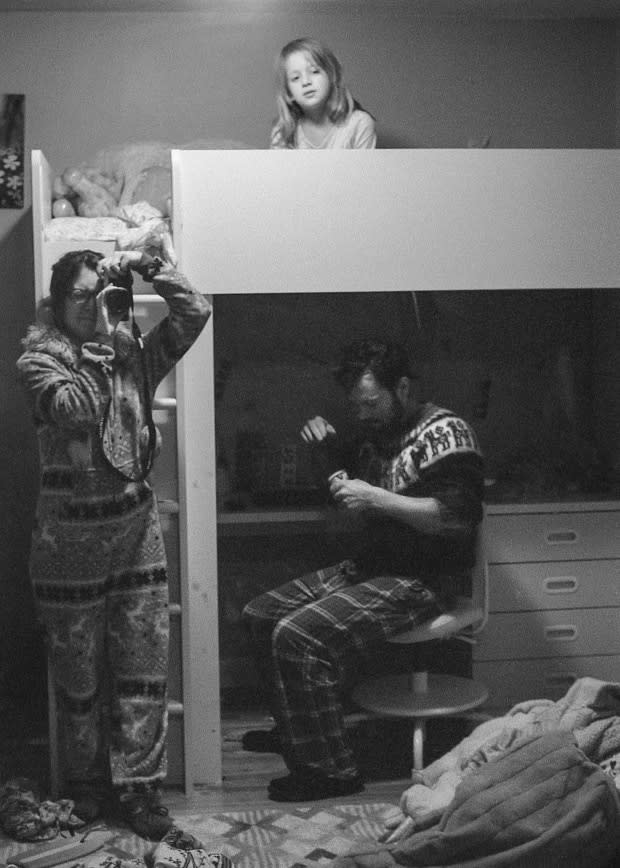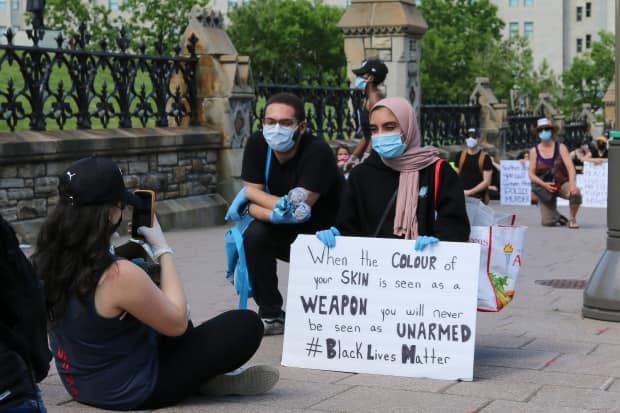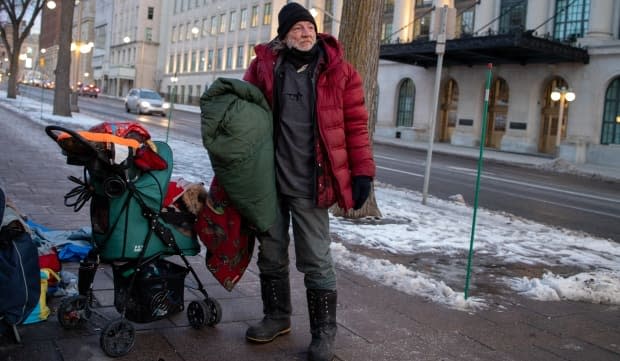Quintessential COVID-19 photos

To mark the one-year anniversary of the pandemic, CBC Ottawa asked four local photographers to choose a single image they'll look back on that captures the mood or essence of COVID-19.
Justin Tang

Freelance photographer Justin Tang was assigned by The Canadian Press to take pictures at one of the very first news conferences with Health Minister Patty Hajdu and Dr. Theresa Tam on January 26, 2020, at Tunney's Pasture. Tang was struck by the stillness of mood.
"It was unnerving — they were really calm," said Tang. He thought: "This can't be good."
In February, Tang was sent to CFB Trenton to photograph the arrival of a charter plane full of repatriated Canadians.
"It [still] felt really far away." said Tang. "How soon that would all change."
Since the start of the pandemic, Tang has taken close to 3,000 photos. But one he took on April 19 of last year stands out for him. It shows a person reflected in the National Arts Centre window, with the now iconic pandemic message, "Everything will be okay".
"There was a real sense of fear of the unknown. And I felt it, too," said Tang. "To me, this photo is a bit of light in the darkness."
Lindsay Irene

Ottawa photographer Lindsay Irene has had to put much of her creative work on hold during the pandemic. A solo show at Enriched Bread Artists was cancelled in June. Plans to launch her award-winning documentary book, The Sex Worker, were delayed.
Irene and her partner separated in the fall of 2019, but had remained on good terms. COVID-19 prompted him to move back in temporarily.
"He just slipped right back into our lives and we just existed in our little bubble," said Irene. "I couldn't imagine doing all of this alone."
They spent the first part of the pandemic watching disaster movies and doing puzzles. Irene, who graduated from the School of the Photographic Arts: Ottawa in 2019, chose as her COVID-19 quintessential picture a self-styled family portrait that she took in the early days of the first wave.
"It was just such a surreal day for all of us," recalled Irene.
"There's this big mirror in front of the bed and I'm like, 'I gotta remember this.' It's actually one of the only photos I have of all three of us, because ... it's always me, the one who takes the photo."
The old-school 35 mm camera was loaded with black and white film.
"When you remove colour, it just focuses your eye and draws you to the subject," said Irene.
Katherine Takpannie

"First and foremost, I'm an Inuk. I am a mother of a wild two-year-old and I am a photographer," said Katherine Takpannie, who also works for the federal government in the Indigenous Programs Directorate, and as a member of the Equity and Inclusion Committee with the city of Ottawa.
As her quintessential COVID-19 picture, Takpannie chose an image taken on June 5, 2020, the day of the No Peace Until Justice rally in Ottawa, organized in the wake of the killing of George Floyd.
At first, Takpannie was conflicted about joining the rally — "We have my father living with us, he's an elder, he has many health issues," she said — but in the end, she donned her mask, brought along her zoom lens, and added her voice.
"How important it was to stand up against systemic racism and violence toward Black people. It was such a higher calling than just staying safe," said Takpannie.
"Everyone wore masks, but everyone wanted to come together," said Takpannie. "Racism is also a pandemic. It is larger than a virus."
Andrew Lee

Andrew Lee is a network camera operator and photojournalist for CBC. When he's not shooting video on Parliament Hill, he's capturing still images on the streets of Ottawa.
"You just see more and more businesses being closed every week. More and more storefronts shuttered," said Lee.
With so many people staying home, those who are visible on the streets are often homeless.
"One fellow said, 'There's just no "inside" for us to go to,'" said Lee.
Lee chose as his representative COVID-19 photo a picture of a homeless man named Rick, who lives with his two small dogs at a makeshift encampment off Wellington Street, near the Parliament Buildings.
Rick told Lee he's originally from Gananoque, that he had a traumatic brain injury that affected his short term memory, and that he's been living on the streets for seven years.
"His chin is held high. That's his little spot in the world and that's where he's decided to be," said Lee. "But I just love the dignity. That's kind of what you hope to capture."

